
About UsThe Numismatic Bibliomania Society is a non-profit organization promoting numismatic literature. For more information please see our web site at coinbooks.org SubscriptionsThose wishing to become new E-Sylum subscribers (or wishing to Unsubscribe) can go to the following web page link MembershipThere is a membership application available on the web site Membership Application To join, print the application and return it with your check to the address printed on the application. Membership is only $15 to addresses in the U.S., $20 for First Class mail, and $25 elsewhere. For those without web access, write to: David M. Sundman, Treasurer AsylumFor Asylum mailing address changes and other membership questions, contact David at this email address: dsundman@LittletonCoin.com SubmissionsTo submit items for publication in The E-Sylum, just Reply to this message, or write to the Editor at this address: whomren@gmail.com
BUY THE BOOK BEFORE THE COIN |
- WAYNE'S WORDS: THE E-SYLUM FEBRUARY 23, 2014
- NEW BOOK: FROM THE SILVER CZECH TOLAR TO A WORLDWIDE DOLLAR
- NEW BOOK: BUFFALO COINS: AMERICA'S FAVORITE
- NEW BOOK: ITALIAN CAST COINAGE, REVISED EDITION
- NEW BOOK: THE ARMSTRONG TOKENS
- SIAMESE COINS IAPN BOOK PRIZE CEREMONY HELD
- JEAN-PAUL DIVO, 1937-2014
- MORE CHOPMARKS ON MODERN U.S. PAPER MONEY
- NOTES FROM E-SYLUM READERS: FEBRUARY 23, 2014
- ERRORSCOPE MARCH-APRIL 2014 ISSUE PUBLISHED
- ALBERT WICK'S AMERICAN COLONIAL COINS & TOKENS
- ANS HUNTINGTON AWARD TO JOHN W. ADAMS
- EDWIN JOHNSTON ON BRAD TROEMEL'S EBAY ART PROJECT
- 150TH ANNIVERSARY OF THE SINKING OF THE HUNLEY
- IF GIVEN A CHOICE, WHICH WOULD YOU CHOOSE?
- EXHIBITS AT THE 2014 ANA SUMMER CONVENTION
- DECLARATION OF INDEPENDENCE MEDAL
- NAPOLEON VAMPIRE TOKENS
- FORUM ANCIENT COINS TRANSLATION PAGES
- GEORG BAUMS: PORTRAIT OF A COLLECTOR
- GEORG BAUMS MEDAL SALE HIGHLIGHTS
- MEDAL OF TSARINA MARIA FEODOROVNA, MEDALIST
- COIN HOARD UNCOVERED IN TWYNHOLM, SCOTLAND
- THE HEMISPHERE COLLECTION OF BRITISH GOLD SOVEREIGNS
- BRITONS SEARCH FOR RARE KEW GARDENS 50P COIN
- ZIMBABWE’S MULTI-CURRENCY CONFUSION
- THE 2014 OLYMPIC MEDALS
- THE LUCKY PENNY RESTAURANT'S WALL OF COINS
- FEATURED WEB PAGE: OLYMPIC WINTER GAMES MEDALS
Click here to access the complete archive
To comment or submit articles, reply to whomren@gmail.com
WAYNE'S WORDS: THE E-SYLUM FEBRUARY 23, 2014

New subscribers this week include David Loder. Welcome aboard! We have 1,706 email subscribers.
This week we open with four new numismatic books, and the IAPN book prize. Other topics include Jean-Paul Divo, an Arabic chopmark on a U.S. banknote, and Albert Wick's American Colonial Coins and Tokens book.
To learn more about bison in American numismatics, Armstrong Shoe Mart tokens, an Incomplete Curved Clip error, Georg Baums' medal collection, the Kew Gardens commemorative coins, Napoleon vampire tokens, and Zimbabwe condom money, read on. Have a great week, everyone!
Wayne Homren
Editor, The E-Sylum
NEW BOOK: FROM THE SILVER CZECH TOLAR TO A WORLDWIDE DOLLAR
 From the Silver Czech Tolar to a Worldwide Dollar: The Birth of the Dollar and its Journey of Monetary Circulation in Europe and the World from the 16th to the 20th Century
From the Silver Czech Tolar to a Worldwide Dollar: The Birth of the Dollar and its Journey of Monetary Circulation in Europe and the World from the 16th to the 20th Century
By Petr Vorel
1st English
June, 2013
Cloth, 270 pages, 84
ISBN: 978-0-88033-705-2
East European Monographs
$55.00 / £38.00
This publication may be of especial interest for American readers in that, perhaps for the first time, the complex power and political relationships existing in Central Europe at the beginning of the early modern period, which led to the emergence of the dollar, are clearly explained. It goes on to explain the relationships that existed between the different thaler currencies that were involved in the development of the European currency systems right up to modern times and explains the reasons why the term "dollar" was used in the late 18th Century, at the time of the founding of the United States of America.
This book offers a very specific perspective on the common historical roots of the contemporary Euro-American civilization and contains significant new information not only for historians concerned with economic and political history, but that is also of importance for numismatists and collectors. The text is illustrated by 84 color photographs of coins and paper currency.
Petr Vorel is a Czech historian, numismatist and Dean of the Faculty of Arts and Philosophy at the University of Pardubice. His long-term research interest is the economic and political history of Central Europe and specifically with the history of monetary circulation. He considers as his most important publications on this topic the books Monetary Circulation in Central Europe at the Beginning of the Early Modern Age – Attempts to Establish a Shared Currency as an Aspect of the Political Culture of the 16th Century (1524-1573), and Silver in the European Monetary Circulation of the 16th and 17th Centuries (1472-1717). At the most recent XXI International Congress of Historical Sciences (Amsterdam 2010) he was the organizer of the independent session “Trade and Civilization from Ancient Times to Present.” Currently he is the Chairman of the Czech National Committee of Historians.
The dust jacket on our copy is maroon, but the image shown here (taken from another web site) looks purple. It seems like a very nice book for numismatists interested in economic history, and economists interested in numismatics. First person to commit to writing a review for The E-Sylum gets the book for the cost of shipping. -Editor
For more information, or to order, see: From the Silver Czech Tolar to a Worldwide Dollar (cup.columbia.edu/book/978-0-88033-705-2/from-the-silver-czech-tolar-to-a-worldwide-dollar)
NEW BOOK: BUFFALO COINS: AMERICA'S FAVORITE
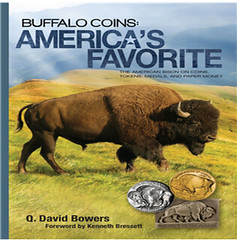 Whitman Publishing announces the release of Buffalo Coins: America’s Favorite—The American Bison on Coins, Tokens, Medals, and Paper Money. The 160-page, full-color book by Q. David Bowers will be available in March 2014 from booksellers nationwide as well as online, including at Whitman.com.
Whitman Publishing announces the release of Buffalo Coins: America’s Favorite—The American Bison on Coins, Tokens, Medals, and Paper Money. The 160-page, full-color book by Q. David Bowers will be available in March 2014 from booksellers nationwide as well as online, including at Whitman.com.
“The American bison, nicknamed the buffalo, is a part of our national history and popular culture,” said Bowers, the coin hobby’s most prolific author. “Nowhere is this great animal more appreciated than in numismatics—the art, science, and enjoyment of collecting coins, tokens, medals, and paper money.” Now, in this richly illustrated new book, Bowers relates the history—and predicts the future—of the “Monarch of the Plains.”
A main focus of the book is the image of bison on American coins (including the famous and popular 1913–1938 Buffalo nickel, State quarters, commemoratives, and others). A chapter on the bison in American pop culture covers songs, advertising, sports teams, postage stamps, Buffalo Bill and other Wild West shows, movies, television, jokes, and more. Finally, Bowers looks forward to the promising future of this noble animal.
Contents include: The American Bison: A History and Appreciation ● The Famous “Buffalo” Nickel ● More Bison in American Numismatics ● The American Bison in Popular Culture ● Selected Buffalo and Bison Places on the Map ● Looking Forward: The Future of the American Bison ● Plus these resources for coin collectors: A Virtual Buffalo Nickel Collection ● A Buffalo Nickel Check List and Record Sheet ● The Three-Legged Buffalo and Other Varieties ● Grading Buffalo Nickels
Buffalo Coins: America’s Favorite will be available online and from hobby shops and bookstores nationwide. Its retail price is $14.95. Members of the American Numismatic Association (money.org) can borrow the book for free from the Dwight N. Manley Numismatic Library.
Buffalo Coins: America’s Favorite—The American Bison on Coins, Tokens, Medals, and Paper Money
By Q. David Bowers; foreword by Kenneth Bressett
ISBN 079483798-0
Softcover, 6 x 9 inches
Full color
Retail $14.95 U.S.
For more information, or to order, see: Buffalo Coins: America's Favorite (www.whitman.com/store/Inventory/Detail/Buffalo-Coins-Americas-Favorite+0794837980)
NEW BOOK: ITALIAN CAST COINAGE, REVISED EDITION
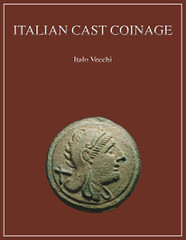 In 1979, Italo Vecchi, along with Bradley Thurlow, published ‘Italian Cast Coinage’. This book was a catalog of all of the then-known types of cast coinage used in Rome and central Italy between the seventh to third centuries BC. In the three-and-a-half decades since its publication, a number of specialized studies have appeared which have revised our knowledge of this coinage, particularly regarding their minting authorities. As a result, Italo Vecchi has produced a new updated edition of ‘Italian Cast Coinage’
In 1979, Italo Vecchi, along with Bradley Thurlow, published ‘Italian Cast Coinage’. This book was a catalog of all of the then-known types of cast coinage used in Rome and central Italy between the seventh to third centuries BC. In the three-and-a-half decades since its publication, a number of specialized studies have appeared which have revised our knowledge of this coinage, particularly regarding their minting authorities. As a result, Italo Vecchi has produced a new updated edition of ‘Italian Cast Coinage’
Listing 327 coin types – from the aes rude and currency bars of early 1st millennium Italy to the final issues during the Second Punic War – many of which are previously unpublished, ‘Italian Cast Coinage’ also includes an account of the cast coinages of Rome, Etruria, Umbria, Northeast and Central Italy, Lucania, and Apulia. Arranged overall by geographical area, the mints within each area are then listed alphabetically. Details of the historical or geographical background, an examination of the weight standards and chronology, and three maps of the area are included also. In addition, there are 90 plates illustrating 373 coins and 14 related items. The book is fully indexed. Soon to become the new standard reference for the cast coinage of Italy. This book will be a useful inclusion into the library of any scholar, numismatist, or collector of coinage of Central Italy and the early Roman Republic.
You can order the book directly from CNG.
To read the complete article, see: ‘Italian Cast Coinage’ in new edition (www.coinsweekly.com/en/News/4?&id=2617)
THE BOOK BAZARRE
NEW BOOK: THE ARMSTRONG TOKENS
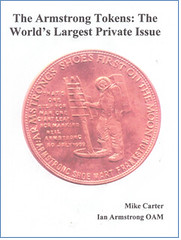 A new full colour catalogue of Armstrong Shoe Mart tokens and associated materials has just been released.
A new full colour catalogue of Armstrong Shoe Mart tokens and associated materials has just been released.
Written by Mike Carter and Ian Armstrong the catalogue picks up from the early work undertaken by Ian’s brother, Harold and Warren Amundsen.
The catalogue includes all known Armstrong Shoe Mart token issues; Hall’s of Toorak issues; and associated materials issued by Ian such as medals and postcards. A rarity rating based on numbers issued has also been included.
Only 100 copies of the catalogue have been printed. As well as the catalogue a new Armstrong Shoemart medal set was produced through the Canning Mint.
Copies of the Catalogue or the new Armstrong Medals are available from Mike Carter or Ian Armstrong directly.
Mike can be contacted on mike.carter@optusnet.com.au.
Cost of the Catalogue is $20; postage $4.
The Medals are $20 each, $60 for the set of three. Postage $2.80 (small padded bag)
SIAMESE COINS IAPN BOOK PRIZE CEREMONY HELD
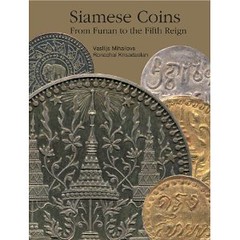 Numismatic authors Ronachai Krisadaolarn and Vasilijs Mihailovs are honored recipients of the annual book prize award from the International Association of Professional Numismatists (IAPN).
Numismatic authors Ronachai Krisadaolarn and Vasilijs Mihailovs are honored recipients of the annual book prize award from the International Association of Professional Numismatists (IAPN).
Conducted annually since 1982, the latest IAPN Book Prize Award Ceremony was held on Jan. 19, 2014 in Bangkok Thailand. More than 100 collectors, dealers, enthusiasts and personal friends of the authors attended.
IAPN honored Krisadaolarn and Mihailovs for their 271-page reference book entitled Siamese Coins from Funan to the Fifth Reign.
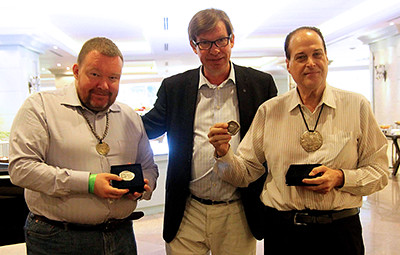
The new book "takes Thai coinage to another level of academics," describes IAPN "The hard cover book is 271 pages, with color images, including graphs and charts discussing the emblems and iconography of Thai coinage. This reference is a definite ‘must have’ for any serious numismatic library."
Until Siamese Coins from Funan to the Fifth Reign came along, IAPN notes that very little was published on Thai coinage with the last major reference solely on the subject written some 80 years ago.
To read the complete article, see: Authors Receive IAPN Award for Book on Siamese Coins (www.coinnews.net/2014/02/19/authors-receive-iapn-award-for-book-on-siamese-coins/)
To read the earlier E-Sylum article, see: SIAMESE COINS BOOK WINS IAPN PRIZE (www.coinbooks.org/esylum_v16n21a05.html)
JEAN-PAUL DIVO, 1937-2014
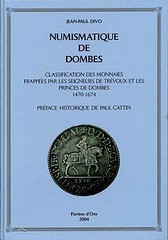 Jean-Luc Van der Schueren, General secretary and Executive Director of the international Association of Professional Numismatists (IAPN) writes:
Jean-Luc Van der Schueren, General secretary and Executive Director of the international Association of Professional Numismatists (IAPN) writes:
I have just been informed that the former IAPN President, Jean-Paul DIVO died on February 13th. He was born on 8th August, 1937. He had been for a long time General Secretary of our Association, and then become its 9th President, being elected in 1997. He quit in 2001, and was then made Honorary President.
Thanks to David Fanning for forwarding the above. He adds:
Among other accomplishments, Jean-Paul Divo was the author of the current standard work on the medals on Louis XIV, based largely on the famous 1702 Médailles sur les principaux événements du règne de Louis le Grand. He also wrote on Swiss talers, Napoleonic medals, modern German, Swiss and Greek coins, the medals of Louis XV and other subjects.
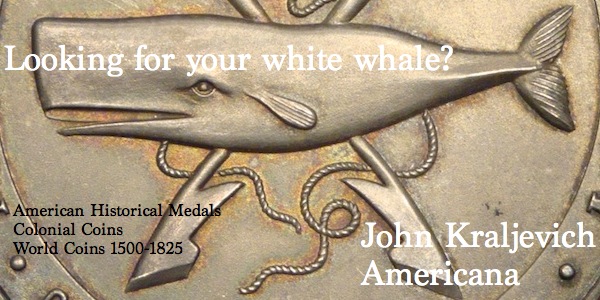
MORE CHOPMARKS ON MODERN U.S. PAPER MONEY
Phil Iversen writes:
Regarding the article on “Chopmarks on Paper Currency” in the Feb. 17th issue I, too, have collected a number of these notes over the years. You mostly find them on the larger size notes ($50 or $100) bills usually with either symbols or even letters, but I also have a few on $1 bills too. I have pulled of circulation a number of $1, $5 & $20 notes with the “Where’s George” stamp plus another dozen or so with message such as “I Love You,” dates or names on them. Always fun to watch out for and collect!
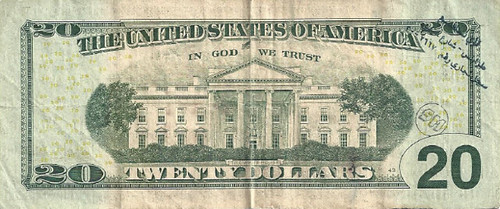
 The text of the stamp, as best I can distinguish smudged blue ink from green ink, is...
The text of the stamp, as best I can distinguish smudged blue ink from green ink, is...
1st line, proper name: Lu'ay Naafi'
2nd line, address: Tripoli [Lebanon] - 'Azmi Street
3rd line, license: Commercial registration number 2 0 - 2 6 6 7
While Arabic reads right-to-left, their numbers read left-to-right, like ours. Not sure why! I also don't know what the "SM" means, but if I learn in the meantime, I'll pass that along as well. Notice that just below the stamp, you can see serial number bleed-through from the front.
To read the earlier E-Sylum article, see: CHOPMARKS ON MODERN U.S. PAPER MONEY (www.coinbooks.org/esylum_v17n07a21.html)
NOTES FROM E-SYLUM READERS: FEBRUARY 23, 2014
Ruth Hill Not a Founding IBNS Member Ron Richardson Editor, IBNS Journal writes:
In response to my colleague Howard Daniel's "correction" to my comment that Ruth Hill was not a founding member of the International Bank Note Society, I would have to point him to the IBNS Journal Vol 50: No 4 of 2011 which has a full listing of the Charter members of IBNS. However, I acknowledge his reference to another copy of the Journal that notes Mrs. Hill was a founding member. That reference is incorrect. I say that with some embarrassment as I was editor of that issue of the Journal and also on the Awards Committee and likely wrote the incorrect reference myself. Everything else Howard writes on the huge contribution Mrs Hill made to paper money collecting I strongly endorse.
To read the earlier E-Sylum article, see: MORE ON RUTH HILL (www.coinbooks.org/esylum_v17n07a13.html)
The Antiquities of the Jews
In last week's review of Coins of the Bible I wrote:
... direct quotations of Bible passages mentioning or referring to coins, such as: "And when Moses had gathered the multitude together again, he ordained that they should offer half a shekel for every man, as an oblation to God; which shekel is a piece among the Hebrews, and is equal to four Athenian drachmae, (Antiquities 3.8.2)"
François R. Velde writes:
That's not a direct quotation of the Bible. "drachma" is a sure sign that the quote isn't biblical - it's too late for the Old Testament and too early for the New one
My mistake. I wasn't the most attentive Sunday School student, but I didn't recognize " Antiquities" as a book from the Bible, but was in too much of a rush to question it. The book's quotes are not all from the Bible as I stated. This one is from a work by Flavius Josephus titled "The Antiquities of the Jews".
To read the Flavius Josephus book, see: Antiquities of the Jews by Flavius Josephus (www.gutenberg.org/ebooks/2848?msg=welcome_stranger#link32HCH0008)
Publisher Dennis Tucker adds:
Money of the Bible, 3rd edition, has been written up for ProtoView (formerly Book News, Inc.’s “Reference & Research Book News”). Their title entries are sent to discovery services that license their content, including Ex Libris:
"This third edition is further updated with more pictures and more anecdotes. Bressett has been involved with numismatics since the 1940s, and this book is a lovingly prepared, abundantly illustrated compendium about money in the ancient world."
It’s always nice to see a numismatic book get some coverage outside our rarefied sphere!
To read the earlier E-Sylum article, see: BOOK REVIEW: MONEY OF THE BIBLE, 3RD EDITION (www.coinbooks.org/esylum_v17n07a06.html)
Palestinian £100 Banknote Image Copyright Howard Berlin writes:
I was surprised to see the picture of the 1929 £P100 note (S/N A001088) issued during the British Mandate of Palestine in the recent issue of The E-Sylum (v17#07 February 16, 2014). It so happens that I was the former owner of this note, of which there are only four known (that are not specimens or color trials). It was the crowning jewel of my collection of Palestine coins and notes that I had collected for over 20 years. I had sold my whole collection back in 2001 after exhibiting various part of it at national, regional and local shows and was fortunate to have won a few best of show awards.
This notes appears both on the paperback cover and as a featured color plate of my book, The Coins and Banknotes of Palestine Under the British Mandate, 1927–1947, which is also copyrighted. The image of this note has long been on my copyrighted webpage about the coins and banknotes of the Palestine Mandate since 1999. What irritates me is that an individual using the Wikipedia ID of Arabmuslim12 has literally stolen this image and placed it on the Hebrew-language Wikipedia site and has the chutzpah to claim that he/she is the author of this work! This thief has indicated that this file is licensed under the Creative Commons Attribution - Share Alike 3.0 Unported, 2.5 Generic, 2.0 Generic and 1.0 Generic license.
In the past I have graciously allowed individuals to use this image for educational purposes when asked as long as the source is acknowledged. An "official" image, which much better view of this note is attached. I now have find out how to have this Wikipedia page deleted or have the proper attribution made.

Image Copyright (c) Dr. Howard M. Berlin
To read the earlier E-Sylum article, see: OSAMA BIN LADEN BANKNOTE (www.coinbooks.org/esylum_v17n07a25.html)
2014 Belgium Coin Sizes Last week I wrote:
"I like the switcheroo of the two metals in this bimetallic design. Are these the same or different denominations? Despite the clear difference, these could get confusing if they're not the same denomination."
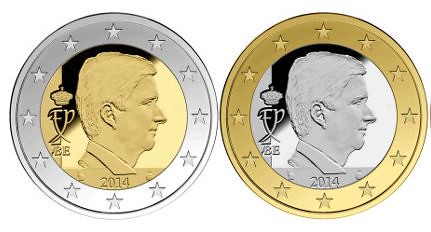
Pabitra Saha writes:
The first one or the one with Copper Nickel ring, is 2 Euro whereas the second one is one euro. The actual coins are different sized.
Denomination: 1 Euro; Composition: Bi-metallic Copper-Nickel Centre in Nickel-Brass Ring; Diameter: 23.25 mm; Weight: 7.5 g; Edge: Segmented Reeding
Denomination: 2 Euro; Composition: Bi-metallic Nickel-Brass Centre in Copper-Nickel Ring; Diameter: 25.75 mm; Weight: 8.5 g; Edge: Lettered with legend
To read the earlier E-Sylum article, see: SOME NEW COIN DESIGNS: FEBRUARY 16, 2014 (www.coinbooks.org/esylum_v17n07a20.html)
1882-CC dollar Variety Correction Steve Bishop writes:
One small correction to Tom Kays' Numismatic diary, which I should have picked up in the preview copy you sent: The 1882-CC dollar was a VAM 2C, not 2A, the difference being that the 2C is a later die state and scarcer, particularly in a GSA holder.
To read the earlier E-Sylum article, see: TOM KAYS' NUMISMATIC DIARY: FEBRUARY 16, 2014 (www.coinbooks.org/esylum_v17n07a16.html)
Treating Book Leather Alan Weinberg writes:
I've got an approx. 10" x 10" x 1 1/2" US Mint-made leather presentation case for my Dr Frederick Rose 1858 Buchanan portrait Congressional Gold Medal. It is bright red leather in quite nice condition with gold-embossed US mint images- Indian Head, Seated Liberty, eagles, etc.
To prevent the leather from drying out or becoming brittle, I'd like to treat the leather with an oil or cream to keep it soft and supple.
When I was a kid, we used to use "Neetsfoot Oil" for our leather baseball gloves. But that was 60 years ago. What did Armand Champa or John Ford use to preserve or bring back to life old leather book bindings? What would you recommend or use? Keep in mind the leather has numerous gilt raised images which I don't want to darken...that may be a factor.
ERRORSCOPE MARCH-APRIL 2014 ISSUE PUBLISHED
New In the ErrorScope
Volume 23 Number 2 – March / April 2014
The latest issue of ErrorScope, CONECA’S (The Combined Organizations of Numismatic Error Collectors of America) bimonthly journal is now at the printers. The March / April issue should be available to members at or around the first of March from the CONECA ErrorScope Online Members Only Area (assessable from the banner at the top of the CONECA homepage) and a hard copy should be showing up in mail boxes to all current members at about the same time.
In this issue, Tanay Wakhare wrote an interesting article on the transitional dime varieties of 1969 – 1970 discussing both the RDV-001 and RDV-002.
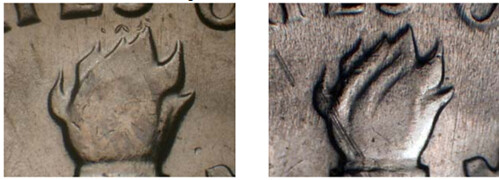
Kevin Flynn who is working on his current book, “The Authoritative Reference on Liberty Seated Half Dimes” and has an article discussing the over date on the Liberty Seated Half Dimes for the year 1848 and 1849. Mr. Flynn goes into detail of the diagnostics of both over dates using close up photographs and overlays.
Ken Potter gives a report on CONECA’S presence at the 2013 Michigan State Numismatic Society’s Fall Convention. Of the several coins examined at the CONECA table highlighted in Mr. Potter’s report was a 1946 DDR-001 (FS-801) Walking Liberty half dollars (strong doubling on eagle’s wing feathers) owned by Karl Brenner and a Canadian 1976 one cent piece exhibiting an “Incomplete Curved Clip” brought to the show by Colin Cutler.
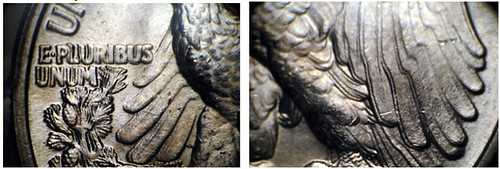
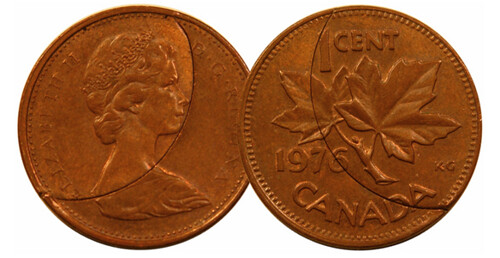
Robert H. Knauss continues his articles of in search of Standing Liberty quarter varieties and errors. In this issue, Mr. Knauss focuses on cuds and die breaks.
Jeff Ylitalo writes about “Bi – Metallic Coins Struck on Solid Denomination Planchets”. Several coins are highlighted including a 2003 Chilean 500 peso struck on a bronze planchet intended for a Chilean 50 peso.
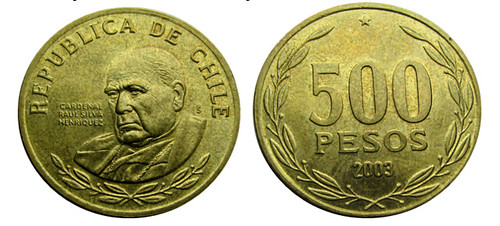
Anybody wanting to join CONECA should contact Rachel Irish at 101 West Prairie Center #323, Hayden, ID 83835 or email MRirish5@roadrunner.com A copy of the application form may be download at http://conecaonline.org/content/join.html. Annual dues are as follows: Adult Member $25.00 per year, Young Numismatist (online ErrorScope only) $7.50 per year or (online ErrorScope plus mailed hard copy) $17.50.
CONECA members wishing to receive a login username and password to access the ErrorScope Online Members Only area, please email the Membership Coordinator, Rachel Irish at the address listed above. A valid email address on file with CONECA is required for access to current and back issues of the ErrorScope online.

Archives International Auctions, Part XVII
Rare U.S. & Worldwide Banknotes, Scripophily, Security Printing Ephemera, Further Selections From the Hamtramck Collection & Part 1 of the Scarsdale Collection of Modern African Banknotes
Highlights include:
- Lot 102 Banco de Quito. 5 Pesos. 1880. Pick #S242 Unlisted as issued note
- Lot 704 Essay Proof of Merchants National Bank of Chicago - a rare essay proof of original issue national banknote
- Lot 394 Central African Republic, 5000 Francs, P-11
- Lot 837 Crescent Mutual Insurance Co., ca.1850's Specimen Stock Certificate
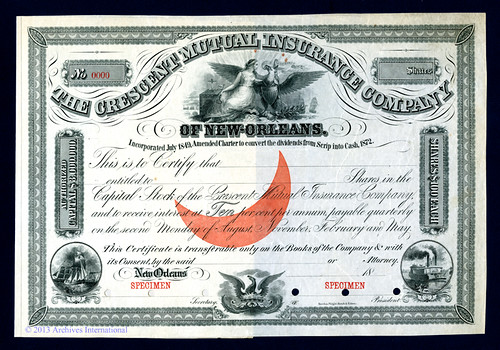
1580 Lemoine Avenue, Suite #7
Fort Lee, NJ 07024
Phone: 201-944-4800
Email: info@archivesinternational.com
WWW.ARCHIVESINTERNATIONAL.COM
ALBERT WICK'S AMERICAN COLONIAL COINS & TOKENS
I came across a book/manuscript that is entitled American Colonial Coins & Tokens by Albert H. Wick. It's a first printing and is dated 1948. The cover is green paper and the contents look like the old mimeograph. Who was Albert Wick and did this book ever have any status?
David Fanning wrote:
Very scarce book. I don't have it in my own library. Don't think I've ever handled one.
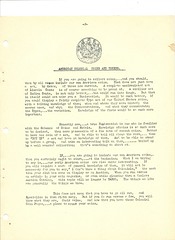
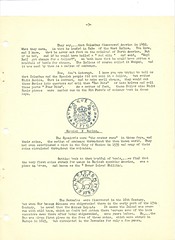
John Lupia forwarded this entry from his Encyclopedic Dictionary of Numismatic Biographies:
Wick, Albert H. (1899-1977), 5437 Nagel Avenue, St. Louis, Missouri. President of the St. Louis Numismatic Society. According to the 1930 U.S. Census he was born in New York in 1899, of two immigrant parents from Germany, Albert (1872-?) and Minnie Wick (1869-?). In 1948 he was appointed District Secretary of the American Numismatic Association.
That same year published his mimeographed book, American Colonial Coins & Tokens. A Review of the Issues from 1615-1792, and placed it in green wrappers. In 1949 he printed a 3-hole punched and stapled red card wrapper in a revised edition (44 pages), also containing History of Evolution of Money (13 pages), and Picking a Winner: A Short Study of American Coins, an Explanation of their High Catalogued Prices, and A Method of Predicting Future Prices of New Issues, Thru a Study of U. S. Mintage Charts (13 Pages). He was the ANA program chairman in 1970 for the convention at St. Louis. He died in March 1977 at his residence at 91340 San Fernando, Los Angeles, California. Bibliography : The Numismatist, Vol. 61, No. 5, May (1948) : 350 The Numismatist, Vol. 78, No. 8, August (1965) : 1259 Numismatic Scrapbook, Volume 36, No. 1 (1970) : 812
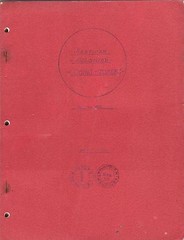 Someone forwarded a link to a copy of the red-covered revised edition. I have the green first edition in my library, but never saw the red one.
-Editor
Someone forwarded a link to a copy of the red-covered revised edition. I have the green first edition in my library, but never saw the red one.
-Editor
To read the complete article, see: Al. [Albert H.] Wick - American Colonial Coins & Tokens. (dunedin.locanto.co.nz/si/1/ID_221283043/Al-Albert-H-Wick-American-Colonial-Coins-Tokens-A.html)
ANS HUNTINGTON AWARD TO JOHN W. ADAMS
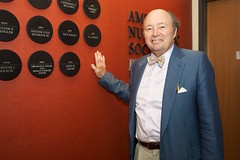 The
American
Numismatic
Society
awards
its
2014
Archer
M.
Huntington
Award
for
excellence
in
numismatic
scholarship
to
John
W.
Adams
The
American
Numismatic
Society
awards
its
2014
Archer
M.
Huntington
Award
for
excellence
in
numismatic
scholarship
to
John
W.
Adams
The Trustees of the American Numismatic Society have voted to award John W. Adams the 2014 Archer M. Huntington Award in recognition of his outstanding career contributions to numismatic scholarship. The award ceremony will be held on Saturday, 26 April 2014 at the Massachusetts Historical Society in Boston. The event will include Mr. Adams’ presentation of the Silvia Mani Hurter Memorial Lecture, Titled A Recidivist Collector, followed by a reception in his honor.
John Adams’ research in the field of numismatics focuses on American and European medals, numismatic literature, and large cents. In his early research, his approach is largely bibliographical. His Monographs on Varieties of United States Large Cents, 1793–1794, published in 1976, provided a concise introduction to the various key publications in this field. His two volumes of United States Numismatic Literature (1982, 1990) are among the most useful bibliographical aids on American numismatic auction catalogues available; in particular Adams’ erudite introductions to the various collectors are widely quoted.
In the last 15 years, Adams has focused primarily on medals, both European and American. His Book The Indian Peace Medals of George III, or, His Majesty’s Sometime Allies, published in 1999, demonstrates his breadth of knowledge; through careful numismatic analysis Adams was able to expand our knowledge in this series. His approach to medals is largely historical, and his subsequent work on The Medals Concerning John Law and the Mississippi System has become a standard work on the peculiar medals satirizing this famous financial crisis of the early 18th century. In this book Adams illustrates his command of historical, financial and numismatic matters. Together with Anne Bentley, Adams Wrote Comitia Americana and Related Medals: Underappreciated Monuments to Our Heritage (2007). In this exhaustive analysis, Adams and Bentley re-‐wrote our understanding of this important early American series of medals. It is now the definitive historical and numismatic study on the subject. Again, in 2010 Adams wrote the consummate book Medallic Portraits of Admiral Vernon: Medals Sometimes Lie with Fernando Chao and in collaboration with Anne Bentley. This work provides a study of the many varieties of the Vernon series, which often differ only in tiny details, provides historical context, offering a concordance with the many prior studies and much more.
While there is an impressive corpus of books by Adams, he also is a frequent contributor to conference proceedings, journals and other publications. He has published articles about coin sales, individual medals, numismatic personalities, and hoards, to name just a few. His long involvement as editor of The MCA Advisory has turned this publication into a popular, well-‐ informed publication.
The Chairman of the Society’s Huntington Committee, Dr. Jere Bacharach, described the honoree with the following words: “What distinguishes John Adams from other writers is his passion for history, a beautiful, academically correct writing style, and diligence in seeking out overlooked historical and numismatic sources.”
John W. Adams received an AB from Princeton (1957) and a MBA from Harvard (1959). He founded Adams, Harkness & Hill in 1966, an investment bank in Boston, where for the next 40 years he served variously as Director of Research, Chairman and CEO. He has served as a Trustee of the Massachusetts Historical Society, where he was instrumental in conserving its coin cabinet, and as President of the Numismatic Bibliomania Society and the Medal Collectors of America. He is a Fellow of the American Antiquarian Society, as well a Fellow of the American Numismatic Society where he also served on its Board of Trustees and was an active Chairman of the Library Committee.
EDWIN JOHNSTON ON BRAD TROEMEL'S EBAY ART PROJECT
As a keen and longtime collector of small independent minters, focusing on those who model their designs based on numismatic history, I was drawn to the E-Sylum article titled, "Money Artist Brad Troemel Exhibition". After reading Troemel's press release in the article I was immediately affronted by the chicanery in regards to his self-described bamboozles on eBay where he alleges he was able to defraud buyers by using altered replicas of US colonial era coins to pass off as genuine, through carefully scripted narratives as his sales tool that were deliberately vague and intentionally misleading.
As a cover for the commission of what appear to me to be crimes, he claims, as all confidence men do, that the buyers' own sense of greed was at fault, just as a thief often does when caught: "He went thatta way!" I found myself in agreement with Wayne Homren's comments regarding Troemel's eBay scams in the article, but balked at supporting Homren's comparison to J.S.G. Boggs for Troemel's gallery exhibition, which I had viewed on the website link and found to be no more artistic than any number of numismatic exhibits at coin shows and conventions.
Despite being miffed, I kept my opinions to myself, at least temporarily. However, the next week's E-Sylum featured an article titled, "A Defense of Brad Troemel's eBay Art Project" by Andrew Hurle, who had initially alerted Homren to Troemel's gallery exhibit, a piece that made me boil over and motivated this response.
It is my impression that Troemel's writing, despite his postgraduate degree from New York University, is evidence of a functional illiterate, most glaringly in terms of numismatics. Hurle's self-styled defense is no doubt meant to seem more educated on its face than Troemel's writing by attempting to situate it within the realm of art, while continuing to obfuscate the apparent criminality of the acts.
Take for instance the simple fact that Troemel personally and with great descriptive effort removed the federally-required identifying "COPY" stamp from his replicas in order to make them appear as authentic currency. Hurle transforms this apparent crime into a creative act of "erasing" and "blurring" the replica into an "empty space" and a "blank" that buyers could fill with their imaginations.
However, the buyers were not alerted to this intent in the very least, if indeed it ever existed at all, since it is more likely a cover story developed after the sales.
Given the facts clearly stipulated in this case, I'm not surprised that both Troemel and Hurle subscribe to the pseudo-anarchistic free market nostrums that are popular among privileged sectors of the digiterati.
What is missing in all this is that Steve Litzner (a.k.a., J.S.G. Boggs), though widely renowned for his artwork that came under government scrutiny without ever having been convicted, was jailed for demonstrable offenses entirely unrelated to art.
To read the earlier E-Sylum articles, see:
MONEY ARTIST BRAD TROEMEL EXHIBITION
(www.coinbooks.org/esylum_v17n06a29.html)
A DEFENSE OF BRAD TROEMEL'S EBAY ART PROJECT
(www.coinbooks.org/esylum_v17n07a14.html)
THE BOOK BAZARRE
150TH ANNIVERSARY OF THE SINKING OF THE HUNLEY
On a clear, moonlight night 150 years ago, the hand-cranked Confederate submarine H.L. Hunley glided out over glassy seas off South Carolina, sailing into history as the first submarine ever to sink an enemy warship.
A century and a half later - and nearly a decade and a half after the sub was raised - just why the Hunley and its eight-man crew never returned is a mystery, albeit one that scientists may be closer to resolving.
Monday marked the 150th anniversary of the Feb. 17, 1864, mission in which the Hunley sank the Union ship Housatonic as the Confederates desperately tried to break the Civil War blockade that was strangling Charleston. While the Housatonic sank, so too did the Hunley.
On Monday evening, re-enactors planned a gathering at Breach Inlet between Sullivans Island and the Isle of Palms northeast of Charleston for a memorial service honoring both the Hunley crew and the five Union sailors who died.
Among the first artifacts recovered from the silt and sand clogging the inside of the submarine were buttons from the crewmen's uniforms.
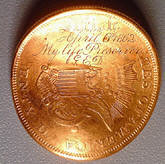 Later came one of the most sought-after artifacts of the Hunley legend - a gold coin that had deflected a bullet and thus saved the life of Hunley commander Lt. George Dixon at the Battle of Shiloh.
Later came one of the most sought-after artifacts of the Hunley legend - a gold coin that had deflected a bullet and thus saved the life of Hunley commander Lt. George Dixon at the Battle of Shiloh.
The $20 United States gold piece was given to Dixon by his sweetheart, Queenie Bennett. The words 'Shiloh April 6, 1862 My life Preserver' are inscribed on the coin.
To read the complete article, see: Memorial service held to commemorate Confederate submarine that sank 150 years ago just as it destroyed a Union warship (www.dailymail.co.uk/news/article-2561549/Memorial-service-held-commemorate-Confederate-submarine-sank-150-years-ago-just-destroyed-Union-warship.html)
IF GIVEN A CHOICE, WHICH WOULD YOU CHOOSE?
E-Sylum readers might get a kick out of this informal study. Last weekend I ran a poll on the Collectors Universe Message Board asking, “If you had a choice of receiving one or the other of these, which would you choose, and why?” The choices were:
a) a ten-pound bag of mixed, completely unsearched 19th-century silver dollars (types unspecified), or
b) a ten-pound bag of mixed, completely unsearched 19th-century U.S. medals and tokens.
As of Thursday afternoon, 77% of respondents said “Show me the dollars!” and 23% said “Gimme the exonumia!”
Personally, as tempting as the silver dollars would be, I would go for the medals and tokens. Early 1800s dollars might include various Bust types, Liberty Seated, even Gobrecht dollars. . . . but 1800s exonumia could include Washington medals, Hard Times and Civil War tokens, Feuchtwanger tokens, Lesher Referendum dollars, U.S. Assay medals (this is all theoretical!), Indian Peace medals. . . . figuring 30 to 50 pieces per pound, I wouldn’t be able to resist.
Some of the respondents’ comments were interesting and surprising:
“I would honestly choose a single circulated common-date silver dollar over option B, since I don't collect medals and tokens.”
“The tokens and medals would be cooler to sort through with all the different designs. That being said, I have NO clue about them so I'd have to go with the dollars.”
“Assuming I have no financial stake in this, I'd probably go with the medals as it would be a more interesting historical lesson. I don't know any medal collectors that collect many multiples of the same design; their collections are quite varied, so it'd certainly be fun to look through. A bag of silver dollars could be all 1881-S.”
“I have already searched thru bags of silver dollars. Never had the chance to go thru a bag of medals/tokens. I would go with the latter just for the experience.”
“Tokens and medals are cool to see pics of and read about. But dollars are fun to own!”
“I'd rather sort through a bag of SBAs than a bag of medals and tokens.”
“I'll go for the dollars and use the money to buy medals and tokens that I have picked out myself!”
“You didn't specify whether we get to keep the sack. Either way, I'd take the medals. The dollars are probably worth more, but what's money for? It's to make us happy and the medals would probably give me more of that than I could buy with the dollars (unless they were all scarce dates).”
I imagine E-Sylum readers would answer more in favor of medals and tokens --- maybe even flipping the ratio from 3-to-1 to 1-to-3.
To read the complete article, see: If given a choice, which would you choose (forums.collectors.com/messageview.cfm?catid=26&threadid=910749&)
EXHIBITS AT THE 2014 ANA SUMMER CONVENTION
Collector Exhibits at the 2014 ANA Summer Convention
The ANA's 2014 Anniversary convention will be held in suburban Chicago on August 5-9, Tuesday through Saturday -- near O'Hare airport, at the same venue as in 1991, 1999, 2011, and 2013. The convention's web site has links to the Rules and Application for exhibiting in 2014 on page: http://www.worldsfairofmoney.com/collector-exhibits.aspx
That page also links to essays on building an exhibit. A good exhibit tells a story, and we all have some stories that we share with fellow collectors; use the Exhibit Area to tell your story for the entire convention! An exhibit can use from one up to ten cases (ANA supplies the cases), and an ANA member can enter up to four exhibits. Only ANA members can exhibit competitively -- that and other rules are detailed in the Rules document.
It takes time and effort to create an exhibit -- now, five months before the convention, is a good time to start. The application must be received at ANA by June 20, but the exhibit need not be complete by then. Do you have questions about exhibiting? If you are attending the National Money Show in Atlanta this week, visit the Exhibit Area and look around.
Exhibiting does take a commitment of time -- the exhibits must be in place by the Tuesday morning opening of the convention, and the exhibits cannot be removed until very late on Saturday afternoon (when the convention closes).
Send any questions to the local committee at ANA2011Exhibits@ChicagoCoinClub.org (that is not a typo -- it means we have a little experience!)

DECLARATION OF INDEPENDENCE MEDAL
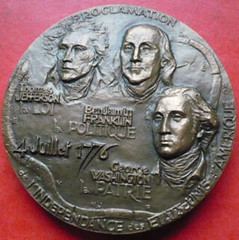

Howard Daniel writes:
This is a new medal to me and which I think is likely of interest to one or more of the E-Sylum subscribers.
Large Bronze Medal. Punch of the edge + Bronze + 1976 Good condition with beautiful Reliefs
Obverse: effigy of the 2 Présidents of the U.S.A + Benjamin Franklin.
Inscription : Thomas JEFFERSON La Loi Benjamin FRANKLIN La Politique George WASHINGTON La Patrie
Inscriptions : PEOCLAMATION DE L'INDEPENDANCE DES ETATS UNIS D'AMERIQUE 4 JUILLET 1776
Reverse: Soldier with a gun and behind the American flag avec une grande inscription + 1776 - 1976
Diameter : 8 cm Weight : 406,5 g
To read the complete eBay lot description, see: MEDAL : ( INDEPENDENCE JULY 4 1776 ) PRESIDENTS OFTHE U.S.A. (www.ebay.com/itm/191073212993)
NAPOLEON VAMPIRE TOKENS
Dave Schenkman writes:
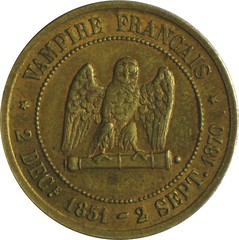 I enjoyed the last E-Sylum, as always, even though I got tagged as part of the “boisterous contingent from Southern Maryland” by Tom Kays. My reason for writing is Tom’s mention of the “Vampire” Francais of Napoleon III le Miserable token he passed around. I don’t know much about these, but have ten or eleven different ones, and wondered whether you know of any catalog or article on them.
I enjoyed the last E-Sylum, as always, even though I got tagged as part of the “boisterous contingent from Southern Maryland” by Tom Kays. My reason for writing is Tom’s mention of the “Vampire” Francais of Napoleon III le Miserable token he passed around. I don’t know much about these, but have ten or eleven different ones, and wondered whether you know of any catalog or article on them.
To read the earlier E-Sylum articles, see:
NAPOLEON III, THE FRENCH VAMPIRE
(www.coinbooks.org/esylum_v15n11a21.html)
FEATURED WEB PAGE: SATIRICAL COINS OF NAPOLEON III
(www.coinbooks.org/esylum_v17n05a27.html)
Bob Leonard writes:
These satirical Sedan pieces refer to the surrender of Napoleon III and his entire army at Sedan, France, September 2, 1870.
Bob Leonard adds:
Certainly. The Numismatist published a series of articles by Richard E. Dickerson, "Military Headgear On The Satirical Coins Of Napoleon III" (December 1974, p. 2507) and "Pickelhaube Medals of Napoleon III" (with W. G. Schulze: November 1975, p. 2405; December 1975, p. 2650; and September 1976, p. 1941). Note: year, month, and page no. from Numismatic Index of Periodicals--probably correct, but I have not verified them, and hope that readers' sets of The Numismatist are easier to get to than mine.)
This was an almost excessively detailed study, going into minutia, so it is no wonder that the ANA has steered away from the subject ever since. No doubt there are French and German publications also, but these four articles will tell you more than you wanted to know.
To read the earlier E-Sylum article, see: TOM KAYS' NUMISMATIC DIARY: FEBRUARY 16, 2014 (www.coinbooks.org/esylum_v17n07a16.html)
FORUM ANCIENT COINS TRANSLATION PAGES
David Pickup writes:
Can I suggest Forum Ancient Coins pages on Numismatic French, Spanish and German? These guides to foreign languages are extremely useful to anyone who buys coins from continental catalogues or websites or uses foreign books.
aber - but
Abkürzungen - abbreviations
abwärts - down (upside down)
Abweichungen - deviations (varieties)
achtel - one eighth
Adler - eagle
Androkephaler Stier - man-faced bull
Ähre - wheat ear
Ährenkranz - wreath of wheat ears
allen - all
auf - on
Anfang - start
antike - ancient
aufwärts - upwards
ausgebreiteten - spread (wings)
To read the complete article, see: German numismatic terms and abbreviations (www.forumancientcoins.com/numiswiki/view.asp?key=Numismatic%20German)
barbada - bearded
cabeza - head
cabeza descubierta - bare head
campo - fields
ceca - mint
creciente - crescent
cruz - cross
debajo - below
detras - behind
encima - above
espada - sword
estrella - star
estrella de cinco puntas - pentagram
To read the complete article, see: Spanish numismatic terms and abbreviations (www.forumancientcoins.com/numiswiki/view.asp?key=Numismatic%20Spanish)
favoris - sideburns
fer de lance - spearhead
fevrier - February
flanque - flanks
grappe de raisin - bunch of grapes
grenetis - beading (dot border)
gauche - left
graveur - engraver
haut - above
isiaque - Isis
joug - yoke
lance - spear
laurier - laurel
To read the complete article, see: French numismatic terms and abbreviations (www.forumancientcoins.com/numiswiki/view.asp?key=Numismatic%20French)
David adds:
Perhaps there could be a Numismatic English page?
Bold fine – nice looking but worn
Uncleaned – dirty
Unresearched - don’t know what it is
Nearly UNC – extremely fine
Some cabinet wear – scratched
Has been pierced – some idiot’s drilled a hole in it
THE BOOK BAZARRE
GEORG BAUMS: PORTRAIT OF A COLLECTOR
 I have known Georg Baums for more than four decades now, and an interested and curious customer has in that period become a friend. He has racked up notable success not only as a collector, but also in his career as an advertising professional. A partner in the advertising agency Baums, Mang and Zimmermann, with over 100 employees, he was from 1971 to 1990 an independent entrepreneur in Düsseldorf. When his company BMZ was sold in 1990 to the international advertising group Publicis, he initially became head of the German branch and was later given responsibility for Austria and Switzerland as well. As Georg Baums left active professional life in 2000 at the age of 65, “his” company had more than 1,000 employees in Germany only.
I have known Georg Baums for more than four decades now, and an interested and curious customer has in that period become a friend. He has racked up notable success not only as a collector, but also in his career as an advertising professional. A partner in the advertising agency Baums, Mang and Zimmermann, with over 100 employees, he was from 1971 to 1990 an independent entrepreneur in Düsseldorf. When his company BMZ was sold in 1990 to the international advertising group Publicis, he initially became head of the German branch and was later given responsibility for Austria and Switzerland as well. As Georg Baums left active professional life in 2000 at the age of 65, “his” company had more than 1,000 employees in Germany only.
Georg Baums didn’t let his busy life prevent him from buying interesting items and adding them to his collection. He wanted to know more, and once expressed it himself in the following manner: “It’s not collecting in the way that honey bees do it. With real collecting, the work doesn’t begin until the item is won. Which stories are there to be found... what the symbols and pictures mean... which other objects have some connection. Investigations, research, examination. That process will not follow the same pattern immediately with each object, nor with the same classification scheme, but in the course of the collection’s life, the mosaic pieces come together more and more to form a whole.”
The medal collection on offer in this catalogue represents the second numismatic project which Georg Baums has entrusted to us for auction. Over more than three decades Georg Baums assembled a significant collection of “siege coins”, which also contained historic medals under the heading “war and peace”. This collection was sold during the 116th auction of the House of Künker on 27 September, 2006 which was, according to Georg Baums, also a major success for the collector.
Through this first focus, Georg Baums was already well acquainted with medals and their specific historic and artistic significance. As a medal collector, however, he no longer wanted to limit himself to a specific subject, but rather to get to know the entire historical span of medals from the Renaissance up to the present, and collect based on various subjects which he personally enjoyed.
Over the centuries, one thing has been generally applicable to medals: within the narrow space which the medal – by its nature as a small object – sets for the artist, he must introduce the subject in such a way that the observer immediately recognizes the subject or historical personality, and is prompted to desire further knowledge. It is the necessity of reduction to the essentials which imparts to the medal its special charm, when the artistic goal is met.
The medal’s origin in the 15th century Italy, whence it spread throughout Europe, represents during the Renaissance for a century simultaneously the period of the greatest artistic blossoming of this miniature artform. Thus in large museums, medals of the Renaissance are rightfully collected and displayed. But the medal collector Johann Wolfgang von Goethe had already established that the originals of Renaissance medals were only rarely to be found on the market. Goethe therefore pronounced himself satisfied with recasts of pieces which interested him. As with so many other collectors, Georg Baums actually wanted to collect only originals. The Renaissance period is thus represented by only a few examples.
Baums became fascinated repeatedly by various subjects, as was the case with a silver medal from 1702, coined on the occasion of the introduction of streetlamps in Leipzig, a discovery at an auction in Zurich. In the course of one decade Georg Baums assembled a collection of more than 1,000 medals. This brought him great pleasure, a phenomenon which must remain unknown to non-collectors. Besides his interest in history he has also attained knowledge and insights which can be valuable to other collectors.
A collection of historical objects never reaches an endpoint. Some objects are only to be found in museums and cannot be bought. But one’s own lifetime creates limits for each collector. My colleague and friend Bernhard Schulte of Basel, who died much too early, once put it so: “All objects which we acquire are really only on loan, either for our lifetime or until they are sold during our lifetime. The price which we pay is a kind of loan fee, which is however more than worth paying in return for the pleasure we receive from the object.” p>
GEORG BAUMS MEDAL SALE HIGHLIGHTS
Lot 5825 – A financial wizard
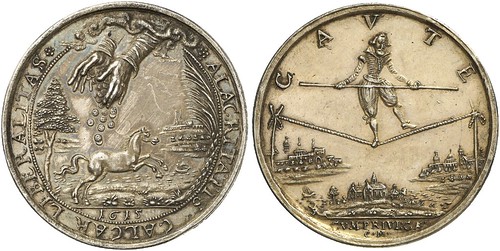
Satirical silver medal in 1615, by Chr painter. Welfenroß jumps r., L deciduous tree, r. Palm branch, in the background ship at sea and city view, top pour two coming from the sky Hands coins on the horse / / Male figure with wand poised vv on a rope that is attached to two palm trees, including three city views. 40.30 mm 22.16 g Brockmann 138; Coll. Fieweger -. Of great rarity. Altvergoldet, especially
Copy of the auction Fritz Rudolf Kuenker 152, Osnabrück 2009, No. 5920th After the comments with Fiala and Deeke this satirical medal should point out the wastefulness and the financial embarrassment of the Duke. The creator of this medal, Christian painter has represented quite positive with the acrobats the financial problems of the Duke. The Duke symbolically poised on a tightrope between the income and expenditure of its treasury. On the obverse of coins pour two hands above his country, represented by the Welfenroß. This is probably meant the extravagance. Descriptive striking photographs to the present day. The transcriptions of clarify on the front: CAVTE (= be careful!) And on the back ALACRITATIS CALCAR Liberalitas (= The driver of happiness is the bounty).
To view the complete lot description, see: Brunswick-Wolfenbüttel. Satirical silver medal 1615 by Chr. Maler. (5350.seu.cleverreach.com/c/13440034/060103fb4d1d-n1e3tc)
Lot 5238 – Strangled with the cravat
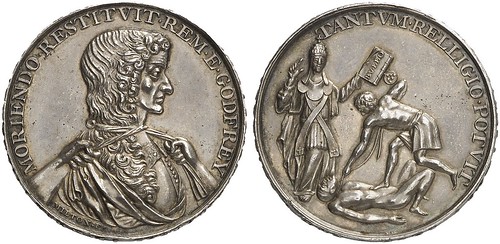
Satirical silver medal in 1678, unsigned, by G. Bower, on the murder of Sir Godfrey Edmundbury. Half-length portrait Godfrey r. with tilted back coat, he is of two hands strangled with his own scarf / / A lying on the ground, naked man is strangled by a man standing over him, in the background given the Pope's blessing. With edge lettering. 39.15 mm 27.71 g bucket 257 a fine tone, excellent
Sir Godfrey Edmundbury (* 1621 Ó1678) was a magistrate in Westminster. In 1678 published an Anglican clergyman, Titus Oates (* 1649 Ó1705), the plan of an alleged conspiracy of the Catholics - to kill Protestants, London burn down to murder the king and to appoint James II as his successor - in the wake of violent recatholicization England . Based on these allegations, which evoked Oates before Godfrey, some Catholics were executed. Godfrey, an active opponent of the intrigues of the Papacy, was then found dead under mysterious circumstances, they brought the Catholics with this murder in connection. Titus Oates, however, was transferred under James II of perjury and punished severely, until King William set him free again.
To view the complete lot description, see: Great Britain. Satirical silver medal 1678 on the assassination of Sir Edmundbury Godfrey. (5350.seu.cleverreach.com/c/13440037/060103fb4d1d-n1e3tc)
Lot 5929 – The graves are looted

Johann Wilhelm, 1690-1716.
Silbermedaille 1693, unsigniert, von J. Smeltzing, auf die Plünderung der Kurfürstengräber in Heidelberg durch französische Soldaten. Büste des französischen Königs Louis XIV. r.//Französische Soldaten bei der Grabschändung. 37,17 mm; 31,40 g. Médailles françaises -; Slg. Memmesh. -; Stemper -; v. Loon IV, S. 64. RR Feine Tönung, vorzüglich
To view the complete lot description, see: Palatinate. Silver medal 1693 by J. Smeltzing on the looting of the graves of the Elector Palatines in Heidelberg by French soldiers. (5350.seu.cleverreach.com/c/13440038/060103fb4d1d-n1e3tc)
Lot 5866 – Inflation and exorbitant grain prices
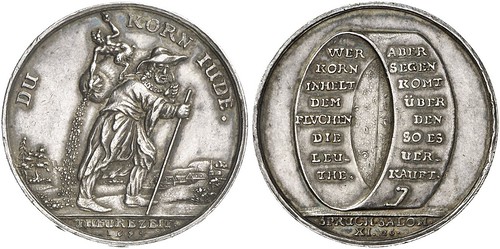
Satirical Silver Medal, 1694, unsigned, Chr Wermuth. Jews ridicule coin, minted on inflation and the grain usury. Jew with hat and walking stick r. in landscape, on the back of a grain sack, on which a little devil sitting and the bag gets torn, so that the grain falls out / / An upright bushel measure with eight line inscription on the wall. 35.84 mm 14.83 g Coll. Fieweger 82; gaed. II, pp. 16, 6,. Welfare 94035 RR Fine tone, exquisite fine specimen
Copy of the auction Fritz Rudolf Kuenker 110, Osnabrück 2006, No. 4825th The concept of grain-Jews since the late 17th Century detectable. Publications of the 18th and 19th Century illustrate the insulting term. In a lexicon of 18 Century there is the following definition: Grain Jews are greedy pros and Aufkauffer of corn that collect and aufkauffen to it verkauffen came also in the time of famine to an unfair price with a wrong Maase without distinction again Getraide to inexpensive times, and therefore thereby causing a famine in the land ... In the years 1693 and 1694 (the year of our medal) was available from Silesia to Württemberg over Germany away heavy rainfall on the one hand and plague of locusts on the other. This led to the rise in grain prices, which called speculators corresponding to the plan. The locusts trains arrived already in 1693 from Turkey through Hungary, they lasted a full two months without interruption. At the ensuing famine, the worst so far, also came still a plague, but in these years is almost a third of the population died. Source: Hubert Emmerig, Grain Jews medals in the Brettauer collection: Money History News, September 2013, Issue 269
To view the complete lot description, see: Hamburg. Corn Jew Medal 1694 by Chr. Wermuth (5350.seu.cleverreach.com/c/13440039/060103fb4d1d-n1e3tc)
Lot 5058 – Silence is golden

Satirical gold ducats to 2 nd, Chr E. Müller, on the secrecy. Two ears, including a mouth / / the nine-line font: WHO WITHOUT / HADER LIVING WILL / MUST fortuitous MUCH / OFFT SILENCE STILL / BECAUSE WHY IS THE / PEOPLE born / WITH A MUNDT / AND ZWEYEN / EARS, above and below, an arabesque including CEM (Christian Ernst Müller, engraver in Augsburg around 1717-1741). 26.17 mm; 6.90 g Forster 619 (there in silver); Coll. Fieweger 226 (there in silver); Coll Brettauer 4826 (there in silver). GOLD. Excellent
The old rule: A mystery remains only one, when really no one knows it. If one keeps in mind it's not so hard to preserve, as people think. You can make one almost as well know as himself, and it does not read but his thoughts. Daniel Quinn in his novel F
To view the complete lot description, see: Satirical gold medal of 2 ducats by Chr. E. Müller on silentness. (5350.seu.cleverreach.com/c/13440043/060103fb4d1d-n1e3tc)
MEDAL OF TSARINA MARIA FEODOROVNA, MEDALIST

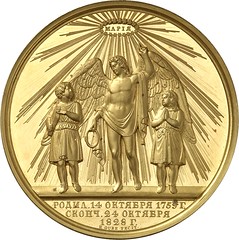
Ursula Kampmann writes:
I have made for Künker a little press release on the most expensive lot, which was sold in the Berlin sale. It's about a German princess on the Russian throne who dedicated her time to design medal dies.
She was a truly remarkable woman, that Sophia Dorothea Augusta Louise of Wuerttemberg, who – as second wife of Paul I - gave birth to two Russian tsars: Alexander I and Nicholas I. Now, a gold medal created on the occasion of her death has been sold at Künker for 180,000 euros!
It is an impressive medal. It exhibits a marvelous portrait of Maria Feodorovna, née Sophia Dorothea Augusta Louise of Wuerttemberg in 1759. The obverse shows a bust of the empress created by P. Utkin. She wears a diadem decorated with oak leaves that represent the Tsarina’s support of the poor among her subjects. On the reverse an angel is depicted surrounded by two shocked children who can only pray sorrowfully. The angel points with his left hand to the eye of God with the name of Maria written within. In his right hand he holds a ring consisting of a snake biting its own tail, as a symbol for eternity which the tsarina has become a part of.
A bidder was willing to pay 180,000 euros for this perfectly preserved rarity. He acquired not just any medal but a piece of German-Russian history because the wife of Paul I was a remarkable woman who improved her family’s love for Germany a lot. By request of Frederick II of Prussia and Catherine II of Russia – both of them were to become known in history as ‘The Great’ –, the 17 year-old came to Russia, her new home. Although historiography often labels Paul I as being difficult and incalculable, Maria Feodorovna got along quite well with her husband in the first years of their marriage. She bore him four sons and six daughters.
Catherine kept the heir to the throne, Paul, away from all political tasks which provided Maria Feodorovna with much time to apply herself to her artistic leanings. She designed cameos, carved ivory and is even said to have produced medal dies. Some Russian medals surely derive from her creativity. It was only after Catherine had died that Maria Feodorovna took over the duties of an empress: she devoted herself to social work, visited and supported hospitals, soup kitchens and orphanages so that the two children on the medal may well represent the ones impoverished she had left behind when she died.
Maria had to deal with the political changes that accompanied the French Revolution. The events in France led to a serious discord between her and her husband who threatened to send her to a convent. She was saved from that fate by the palace coup of 1801 that cost her husband his life.
After his death, the tsar’s widow continued to be a decisive factor at court. She influenced her two sons Alexander and Nicholas in her – i.e. conservative – interests and pursued ambitious marriage politics: her daughters married an archduke of Austria, the Hereditary Prince of Mecklenburg-Schwerin, the Grand Duke of Saxe-Weimar-Eisenach, the King of Wuerttemberg as well as the King of the Netherlands. Her sons were being given wives that came from Baden, Saxe-Coburg-Saalfeld, Prussia and Wuerttemberg. Acting as the center of her family, whose members were dispersed throughout Germany and Europe, she managed to influence political decisions again and again.
Maria Feodorovna died in Pawlowsk in 1828 at the age of 69 years. The medal that was issued on the occasion of her death realized 180,000 euros, hence 220,000 euros including buyer’s premium, at the Berlin auction sale of Künker’s on 6 February 2014! And that was only the peak result of an incredible auction day. 7.4 million euros was the turnover on a single day. Seven lots obtained prices in the six-figure region. You may find all results at the Künker website at www.kuenker.de
702 Hammered down at 180.000 euros, the new owner had to pay more than 220,000 euros for this extremely rare and magnificently preserved gold medal of Tsarina Maria Feodorovna in the end. This is a telling example of the large number of impressive results achieved in Berlin on 6 February 2014. The turnover of a single day read 7.4 million euros.
EMPLOYMENT OPPORTUNITY!
Live and Work in Southern CaliforniaStack’s Bowers Galleries offers an important employment opportunity for the right person. We are seeking an experienced numismatist in the American series—coins, tokens, medals, and paper money—to work with our “dream team” of catalogers, building on the tradition of the Ford, Eliasberg, Bass, Cardinal, Norweb, Battle Born and other great collections.
If you can write in an authoritative and compelling manner with a high degree of accuracy, this may be just right for you! You will be working in Irvine, a modern community in dynamic Orange County, California—one of the finest areas to live. We offer generous benefits including medical and dental coverage, 401K plan, and more. Our offices are in our own modern, state-of-the art building with all amenities.
If you would like to be considered for this position please contact Q. David Bowers by mail or by email with your resumé, samples of your past writing (on numismatics or other subjects), and salary requirements: Mail to the attention of Q. David Bowers, PO Box 1804, Wolfeboro, NH 03894. Email to: Ckarstedt@stacksbowers.com
COIN HOARD UNCOVERED IN TWYNHOLM, SCOTLAND
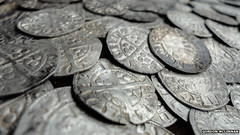 Two men have uncovered what is believed to be the biggest collection of medieval silver coins ever found using metal detectors in Scotland.
Two men have uncovered what is believed to be the biggest collection of medieval silver coins ever found using metal detectors in Scotland.
Gus Paterson and Derek McLennan, from Ayrshire, made the find in a field at Twynholm, near Kirkcudbright, shortly before Christmas.
After several return visits, their haul now tops 300 coins.
They will show them to local residents before handing them over to the Crown as treasure-trove.
Mr McLennan said they suspected the field would yield something interesting, but were on the verge of giving up when they first made the discovery.
"We had done quite a lot of research and had targeted that particular area and we had searched several fields around it before we stumbled across it," he said.
To read the complete article, see: Ayrshire treasure hunters uncover Twynholm silver coins (www.bbc.co.uk/news/uk-scotland-south-scotland-26030715)
THE HEMISPHERE COLLECTION OF BRITISH GOLD SOVEREIGNS
A collection of Gold Sovereigns that spans 525 years, 15 Monarchs and seven mints, will be offered for sale by London based auctioneers, A. H. Baldwin & Sons Ltd, on Thursday 8th May 2014. The comprehensive date collection of 394 Sovereigns from the earliest hammered examples to modern milled is entitled The Hemisphere Collection and follows hot on the heels of The Bentley Collection of British Gold Sovereigns, sold by Baldwin’s during 2013 for £3,994,638.
Formed over 10 years from 2003, the current owner’s fascination with the history of the Sovereign has culminated in the only private collection known to the auction house that contains examples of each and every monarch for the Sovereign denomination.
Steve Hill, Director of British Coins at Baldwin’s said: “We felt 2014 was the year to expand on the success of last year’s sale of The Bentley Collection. The Hemisphere Collection is the first of its kind to track the Sovereign journey from its inception, circa 1500, to today, offering a new generation of collectors the opportunity to embrace the Sovereign, an integral part of British numismatic history and one of the world’s most respected gold coins.”
“In comparison to The Bentley Collection, The Hemisphere Collection brings together both handmade hammered and machine made milled coinage to give the fullest outline of the Sovereigns history, offering collectors of both hammered and milled Sovereigns an unprecedented opportunity to celebrate the denomination together.”
Amongst the modern milled coins on offer is an extremely rare example from the reign of King Edward VIII, who abdicated from the English throne just 326 days after his accession and an Elizabeth II Gold Proof Sovereign 1953, with an impeccable provenance, examples of which were never issued for private collectors.
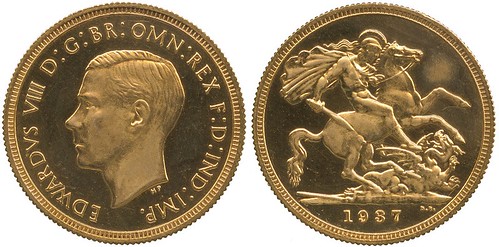
The King Edward VIII, Gold Proof Sovereign dated 1937, is a legendary coin of the highest rarity. Never produced as a currency issue, due to the controversial abdication of the King, the sovereign was part of a proposed set, or a proof set, that was to be authorised as new coinage ahead of the King’s Coronation in 1937.
After the death of Edward’s father, King George V, in January 1936, Edward ascended the throne and coin proposals were produced carrying the head of the new monarch. Edward refused to follow the tradition established by King Charles II that dictated the portrait of each ascending monarch should face the opposite direction to his, or her, predecessor. The tradition had been followed by every monarch, with the exception of Edward VIII, who preferred his left facing profile and insisted on facing the same way as his father. The coin is estimated at £250,000-300,000.
Edward had a number of affairs with married women before meeting American divorcee Wallis Simpson in the 1930s. Against the wishes of his father he developed a relationship with her and famously abdicated his throne on the 10th December 1936 for the woman he loved so fervently, making him the first British monarch to do so voluntarily. Edward and Wallis Simpson married soon after and Edward’s brother George became the next King of England.
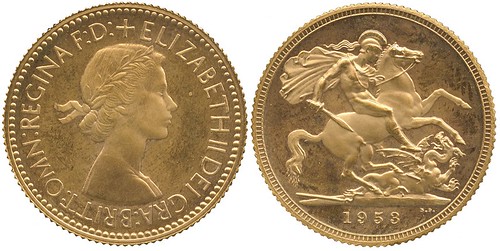
A 1953 Elizabeth II, Gold Proof Sovereign is one of the most valuable coins of our current queen, and beside the Edward VIII Sovereign, is the second rarest of the modern Proof Sovereign series. From her coronation year, the proof set was never issued for public sale, instead, a limited number were produced for national institutions to display publicly for the Coronation.
This example belonged to The National Museum of Wales, who sold and dispersed their set, with official permission, sometime after The Royal Mint moved to Wales. This example, appearing at auction for the very first time, has excellent provenance and offers bidders the opportunity to secure a piece of modern history. It is estimated at £250,000-300,000.
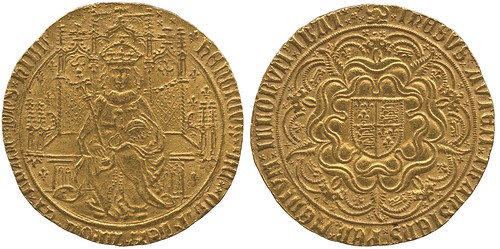
Introduced as a political propaganda tool to emphasise the stability and power of the King after the long and bloody War of the Roses, the Sovereign was first presented by King Henry VII in October 1489, with the earliest example in The Hemisphere Collection, a hammered Henry VII, struck circa 1502-1504.
It was the largest coinage in both size and value, with the reverse bearing the double Tudor rose, symbolising the union of the York and Lancaster Houses, and reinforcing its political message. This very well persevered example is an important piece of the denominations history and is estimated at † £100,000-120,000.

The Sovereign continued to be issued by the Tudor and Stuart Monarchs until the reign of James I, whereupon it appeared in different later guises termed as ‘Pound’, ‘Unite’ and ‘Laurel’ for over 200 years until the re-coinage of King George III in 1816-17. From here the history of the Sovereign is revived and The Hemisphere Collection continues, with the rarest London Royal Mint Sovereign, an 1819 George III.
Much smaller in size and weight, the new, redesigned sovereign adopted the iconic and patriotic design depicting St. George slaying the dragon, designed and engraved by Chief Medallist for the Royal Mint, the Italian artist Benedetto Pistrucci.
This Sovereign is one of only eight currency examples known to exist, and has never been offered at public auction before. The only previous record of the coin is as a plate coin in the Royal Mint publication Royal Sovereign 1489-1989, issued for the 500th anniversary of the Gold Sovereign. It is estimated at £50,000-60,000.
The Hemisphere Collection will be offered as a single sale in London on Thursday 8 May 2014. The catalogue will be available to view online at www.baldwin.com and online biding with no additional premium is available through the services of www.the-saleroom.com. For more information about this historic collection and a preview catalogue please visit www.baldwin.co.uk .
For more information, see: www.baldwin.co.uk
BRITONS SEARCH FOR RARE KEW GARDENS 50P COIN
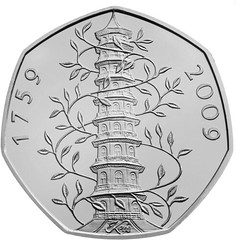 People are being advised to check their change after an “incredibly rare” 50p coin was identified by the Royal Mint as the most uncommon design ever to be placed in circulation in the UK.
People are being advised to check their change after an “incredibly rare” 50p coin was identified by the Royal Mint as the most uncommon design ever to be placed in circulation in the UK.
It has been estimated that around one in 300 of us could have one of the coins in our possession – and the finest examples are listed online as for sale at almost £120 each.
The unusual commemorative 50p piece went into circulation in 2009 to mark the 250th anniversary of the Royal Botanic Gardens at Kew.
Designed by Christopher Le Brun, shows the pagoda of the Gardens encircled by a twisting vine plant and bears the dates 1759 and 2009 and the word “Kew” at the bottom.
The Mint described the coins as “incredibly rare”, with just 210,000 of them ever released.
This compares to the 22.7 million 50p coins produced in 2008 with the shield of the Royal Arms, or the 7.5 million designed in 2010 to celebrate Girlguiding. There are estimated to be around 28.9 billion UK coins in circulation overall.
The Kew Gardens coin is already in demand among collectors, and the Mint said it could “disappear from circulation” altogether when the public realises its value.
A spokeswoman at the Royal Mint said that while the face value of the coin remains 50p, “what it is worth to collectors is another matter”.
Several examples have sold recently for more than £20 on the auction website eBay, and one example that comes with its own protective case and registration number – and in mint condition, of course – is on sale with the London Coin Company for £119.95.
To read the complete article, see: Kew Gardens 50p coin: ‘Incredibly rare’, worth up to £120 – and one in 300 of us has one (www.independent.co.uk/news/uk/home-news/kew-gardens-50p-coin-is-incredibly-rare-worth-up-to-120--and-one-in-300-of-us-has-one-says-royal-mint-9141817.html)

ZIMBABWE’S MULTI-CURRENCY CONFUSION
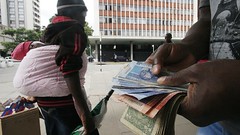 Once known for its billion dollar notes and hyper-inflation, Zimbabwe must be the only place in the world to have eight currencies as legal tender - none of them its own.
Once known for its billion dollar notes and hyper-inflation, Zimbabwe must be the only place in the world to have eight currencies as legal tender - none of them its own.
For the last five years most people have been using US dollars or South African rand, but pula from Botswana and British pound sterling have also been changing hands.
Now the central bank is also allowing the use of Australian dollars, Chinese yuan, Indian rupees and Japanese yen.
For the moment, customers can open bank accounts in these currencies but the hard cash is not yet in circulation.
"I definitely think there is going to be confusion being caused by so many currencies - for a cashier to be handling so many currencies at the same time," says Denford Mutashu, general manager of Food World, a nationwide supermarket chain.
Currently most shops in the capital, Harare, mark prices in US dollars. The rand is more commonly used in Bulawayo, closer to the South African border - and cashiers check daily exchange rate for conversions.
Given the complexities of the multiple currency system, there are now fears that forgery will be easier with unfamiliar notes.
Zimbabwe's liquidity crisis means shopkeepers and market traders often give change in sweets, airtime for mobile phones and even condoms.
One elderly shopper in Food World, buying 5kg of the staple food, maize meal, says the severe cash shortages, which meant the festive season was hard to endure, make her nostalgic for the Zimbabwean dollar.
"We want our currency, we want our Zimbabwean money," she says.
To read the complete article, see: Zimbabwe’s multi-currency confusion (www.bbc.co.uk/news/world-africa-26034078)
THE 2014 OLYMPIC MEDALS
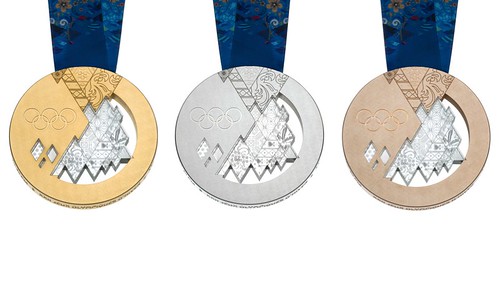
Today at the IOC executive board meetings in St. Petersburg, the medals for the 2014 Sochi Olympics were officially unveiled. Uh, Russia? It looks like a big chunk is missing. The medals were designed by the Leo Burnett advertising agency, who beat out actual design firms and jewelers for the contract. Here's the description, from the Sochi organizers:
The Sochi 2014 Olympic and Paralympic medals are unique and feature the Sochi 2014 "Patchwork Quilt" – a mosaic of national designs from the various cultures and ethnicities of the Russian Federation. The medals have been carefully crafted to depict the landscape of Sochi from the sun's rays reflecting through the snowy mountain tops onto the sandy beaches of the Black Sea coast.
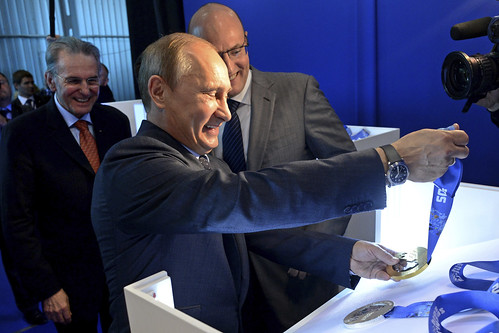
To read the complete article, see: Here Are The 2014 Olympic Medals (deadspin.com/here-are-the-2014-olympic-medals-510440553)
THE LUCKY PENNY RESTAURANT'S WALL OF COINS
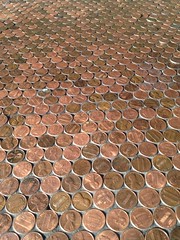 We often feature articles on interesting ways that homeowners, decorators and artists incorporate coins into their projects. This restaurant in Santa Barbara, California sports an entire wall covered with Lincoln cents. We discussed it in September 2013 - Tom Sheehan forwarded these new photos of it. Thanks!
We often feature articles on interesting ways that homeowners, decorators and artists incorporate coins into their projects. This restaurant in Santa Barbara, California sports an entire wall covered with Lincoln cents. We discussed it in September 2013 - Tom Sheehan forwarded these new photos of it. Thanks!
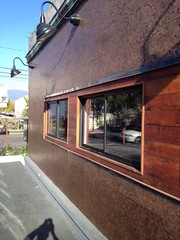
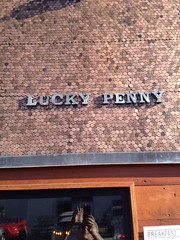
To read the earlier E-Sylum article, see: SANTA BARBARA LUCKY PENNY RESTAURANT HAS WALL OF COINS (www.coinbooks.org/esylum_v16n39a24.html)
FEATURED WEB PAGE: OLYMPIC WINTER GAMES MEDALS
This week's Featured Web Page is about the Olympic Winter Games medals, from 1924 to date. It's from the site of the Olympic organizing committee.This document looks at the evolution of the Olympic Winter Games medals, from the first Games in Chamonix in 1924 to those in Sochi in 2014. Each medal is presented with a photo of its obverse and reverse, with a description of the design and the technical details available.
Taking a journey from the first Winter Games to the start of the 21st century using the emblematic Olympic medals is a fascinating artistic and cultural experience.
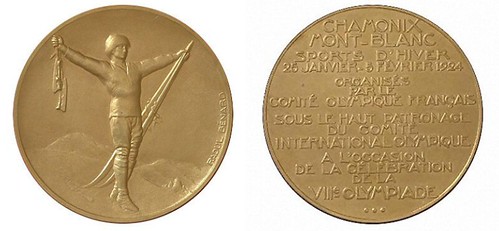
www.olympic.org/Assets/OSC%20Section
/pdf/QR_2E.pdf

